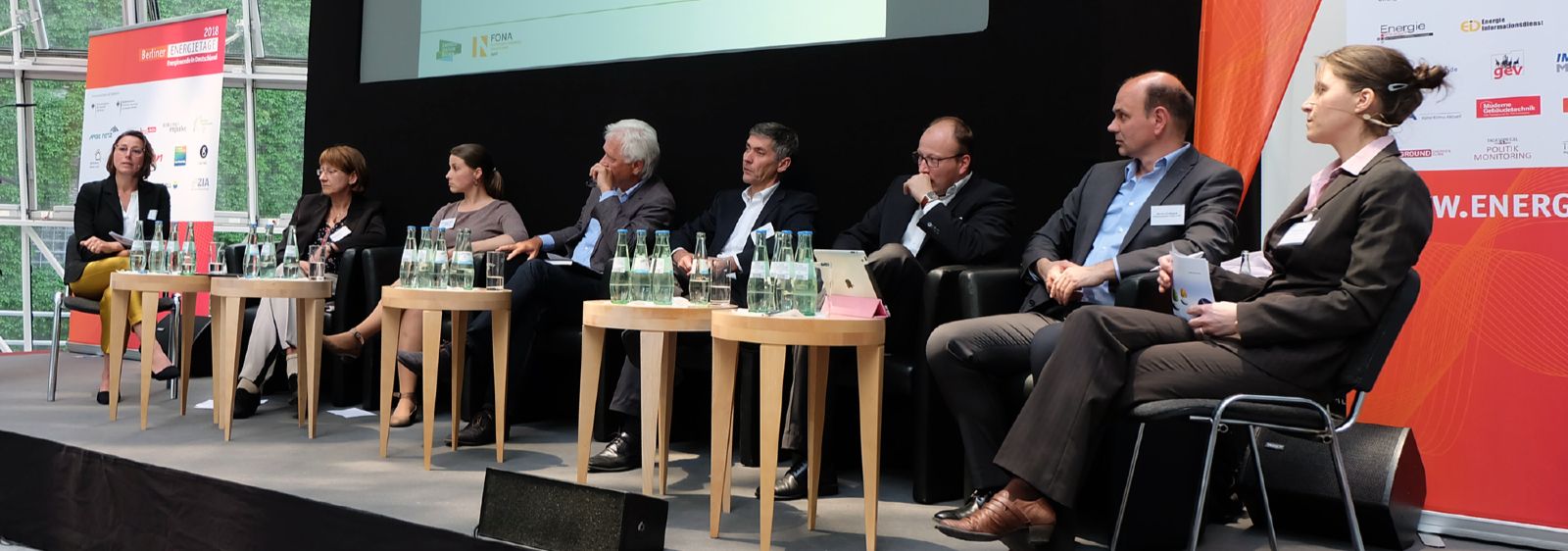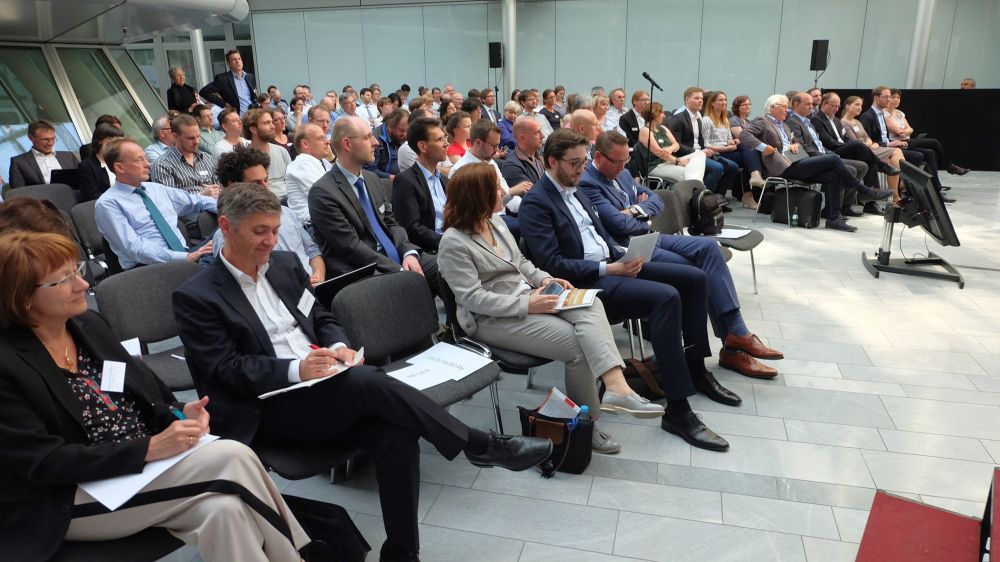
Climate-neutral districts
New ways of residential districts, tested in the reality labs
How can districts get by with energy efficiency measures and the use of renewable energies almost without fossil fuels? How can intelligent networking of electricity, heat and mobility be achieved? These questions are examined in six lighthouse projects by scientists and other actors in urban districts of various uses. Initial results, local challenges, but also parallels in their work were explained by the research teams in a panel discussion at the Berlin Energy Days.
Three quarters of Germany's population live in city districts. A large proportion of Germany's final energy is consumed by private households, the transport sector, trade and infrastructure. High-energy buildings and urban districts must therefore be built and modernised together with an energy-optimised infrastructure. The Project Management Jülich (PtJ), the Federal Ministry of Economics and Energy (BMWi) and the Federal Ministry of Education and Research (BMBF) have invited the projects to the presentation of the Berlin Energy Days 2018 under the title " Energy-efficient City - Districts as reality labs". Dr. Lukas Bo Völkel (BMBF) emphasised in his statement that it is now time to implement the upheaval in the ongoing operation of a district and to involve citizens. Dr. Rodoula Tryfonidou (BMWi) explained in her introduction that the reality labs will be anchored in the new energy research programme as a new format and third pillar alongside basic and applied research. The six lighthouse projects cover the diversity of German districts, so that the results should be transferable.
The researchers took the opportunity to present their approaches to a broad audience. Subsequently, an open panel discussion with the actors was held to discuss both the possibilities and the limits of a reorientation of urban districts.

News from the lighthouse projects
Using locally generated wind power in the district
The "Rüsdorfer Camp" district in Heide is to be almost completely supplied by renewable energies from the region in the future. Wind energy is abundant in the region, so that up to 4,000 gigawatt hours of electricity from wind energy are not used annually. The aim is to use this electricity systematically for the regional energy system and to supply heat, electricity and mobility and to use excess electricity to produce hydrogen. This is suitable as a flexible storage medium for electric mobility. A "filling station of the future" is planned, offering hydrogen, methane and electricity for vehicles.
Climate-neutral district to be built on former factory premises
The city of Kaiserslautern is facing a special challenge by planning and building a new city district on an old conversion site, the former factory premises of the Pfaff sewing machine factory. One focus of the research project is to involve all participants - including citizens - in the planning processes right from the start and to link energy-related district planning with urban development planning. A laboratory has already been built in the former boiler house of the Pfaff factory. Here, the planned developments of the district can be experienced and seen by laymen and experts using virtual reality technologies.
Socially compatible and smart housing model in Zwickau
The Zwickauer district Marienthal is a homogeneous residential area with apartment buildings. There is plenty of living space available in Zwickau, so that the planned measures should in no way lead to an increase in the warm rent. In the future zero-emissions quarter, the scientists are investigating three supply concepts. A part of the district serves as a reference area and is only equipped with measuring technology. In contrast, the two other subareas pursue a centralized and a decentralized approach with an intelligent linking of the existing energy supply structures. The aim is to flexibly adapt the supply of heat and electricity to the needs of the residents.
Former air base becomes an energetic neighbourhood district
The example of a former military area of the city of Oldenburg will demonstrate how an innovative multimodal energy network, which links the electricity, heat and electromobility sectors, could look in concrete terms. In the run-up to the research project, citizens were involved in the planning process as part of a participation process. In the newly emerging climate-neutral residential district, it is planned to involve the residents as energy producers and consumers in the construction and operation of an energy-neutral neighborhood. A central energy trading platform is to be created which can be transferred to other districts.
Urban districts 2050
In contrast to these research projects, the "Stadtquartier 2050" project aims to supply two districts in a climate-neutral manner: one in Stuttgart and a second in Überlingen. The aspect of ensuring a socially acceptable development of rents plays an important role here. On the one hand there is a former hospital area in Stuttgart, an urban district and on the other hand a peripheral development in Überlingen, which is largely rural. Despite these different conditions, similar requirements exist for both districts, as both rural and urban areas occur. A local heating supply is planned that integrates local renewable energy sources. Results and experiences are to be made available to other municipalities via an urban platform.
Climate-neutral urban district Weststadt
In the new "Weststadt" in Esslingen, a district with a climate-neutral building stock is being built. A key component of the concept is the use of renewable electricity surpluses. A central supply structure is to be set up in the middle of the district. The heart of this central unit is an electrolyser that converts this electricity into hydrogen and stores it. Most of the hydrogen produced is then fed into the existing natural gas network, but can also be used for mobility and by industry if required. If electricity is needed again, hydrogen can be converted back into electricity in fuel cells or combined heat and power plants. Public transport will also be integrated into the district concept and supplied with electricity from the district. In Esslingen, 30% of buses already run on electricity from transmission lines; in the future, up to 80% of buses are to be powered by lithium-ion batteries. At the same time, the buses support network operation.
The reality lab in the district – the subject of lively discussions
The term "reality lab" provided much material for the discussion. This should emphasise that concepts and efficiency measures are tried out under real conditions in the district - naturally according to locally defined and accepted conditions. In a lively district, however, this is only possible to a limited extent. The participants in the panel discussion agreed on one thing: it is necessary to create a legal framework for this type of experimental research or to adapt the existing framework conditions accordingly and to anchor them in the renewable energy law (EEG), the German Building Code and in the local urban development planning. It would be helpful to explain the term "reality lab" to the public in order to avoid future acceptance problems on site.
The internal networking of researchers and their findings was also a topic of discussion, i.e. how the exchange of information between the collaborative projects is ensured. In addition to the usual project meetings, this task will be performed by a so-called synthesis project which will be launched shortly.

